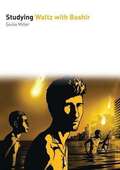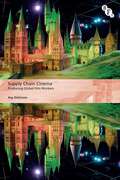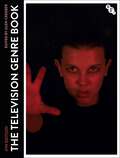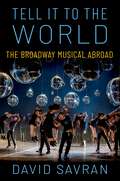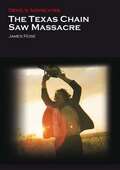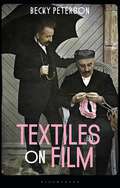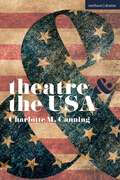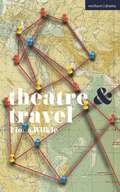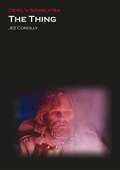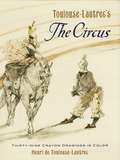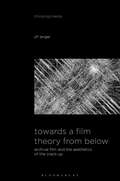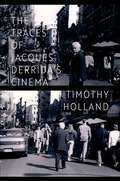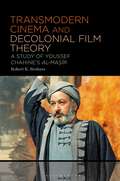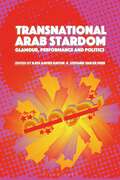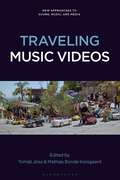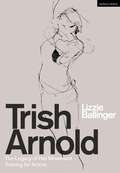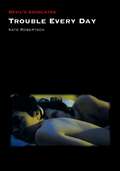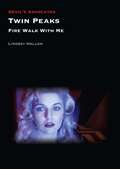- Table View
- List View
Studying Waltz with Bashir (Studying Films)
by Giulia MillerOn its release in 2008, Ari Folman's animated documentary Waltz with Bashir was heralded as a brilliant and original exploration of trauma, and trauma's impact on memory and the recording of history. But it is surprising that although the film is seen through the eyes of one particular soldier, a viewpoint portrayed using highly experimental forms of animation, this has not prevented Waltz with Bashir from being regarded as both an "autobiographical" and "honest" account of the director's own experiences in the 1982 Lebanon war. In fact, the film won several documentary awards, and even those critics focusing on the representation of trauma suggest that this trauma must be authentic. In this sense, it is the documentary form rather than the animation that has had the most influence upon critics.As Studying Waltz with Bashir will show, it is the tension between the two forms that makes the film so complex and interesting, allowing for multiple themes and discourses to coexist, including Israel's role during the Lebanon War and the impact of trauma upon narrative, but also the representation of Holocaust memory and its role in the formation of Israeli identity. In addition to these themes that coexist by virtue of the film's unusual animated documentary format, Waltz with Bashir can also be discussed in relation to a broad range of contexts; for example, the representation of war in film, the history of Israeli Holocaust cinema, and recent trends in experimental animation, such as Richard Linklater's Waking Life (2001) and A Scanner Darkly (2006), as well as Folman's most recent live action/animation work The Congress (2013).
Supply Chain Cinema: Producing Global Film Workers (International Screen Industries)
by Kay DickinsonWhy are big budget films typically made across an array of seemingly dissociated sites? Supply Chain Cinema shows how the production journeys of such films exemplify the principles of the supply chain, whose core imperative is to nimbly and opportunistically manufacturing wherever is most amenable and efficient.Through extensive on-site investigations and in-depth interviews with film professionals, Kay Dickinson delivers nuanced insight into working practices in the UK and the UAE. Among the sites she examines is Warner Bros' permanent base at Leavesden Studios near London. From tax breaks designed to attract foreign projects to infrastructures, logistical support and expertise offered, she considers why Hollywood giants elect to make more of their films in Britain than in the USA. Dickinson goes on to show how the UK's ambitions to enlarge its creative economies has opened up a host of competitive advantages with British higher education increasingly fashioned to conform to the needs of border-hopping enterprise, thus generating a workforce keenly adapted to the demands of blockbuster moviemaking.
The Television Genre Book
In this new edition of The Television Genre Book, leading international scholars have come together to offer an accessible and comprehensive update to the debates, issues and concerns of the field. As television continues to evolve rapidly, this new edition reflects the ways in which TV has transformed in recent years, particularly with the emergence of online streaming services such as Netflix, Disney+, HBO Max and Amazon Prime. It also includes a new chapter on sports TV, and expanded coverage of horror, political thrillers, Nordic noir, historical documentary and docu-drama. With analyses of popular shows like Stranger Things, Killing Eve, The Crown, Chernobyl, Black Mirror, Fleabag, Breaking Bad and RuPaul's Drag Race, this book offers a comprehensive understanding of television genre for scholars and students alike.
Tell it to the World: The Broadway Musical Abroad
by David SavranWhat happens when Broadway goes abroad? Tell It to the World: The Broadway Musical Abroad offers a look at how the Broadway musical travels the world, influencing and even transforming local practices and traditions. It traces especially how the musical has been indigenized in South Korea and Germany, the commercial centers for Broadway musicals in East Asia and continental Europe. Both countries were occupied after World War II by the United States, which disseminated U.S. American popular music, jazz, movies, and musical theatre in the belief that these nations needed to rebuild their cultures in accordance with U.S. guidelines. By the 1990s, Broadway imports had become phenomenally popular in Seoul and Hamburg while home-grown musicals proliferated that adapted and transformed the prototypes that had been disseminated by the U.S. Although this book focuses on recent musicals, it also looks back through the twentieth century to plot the evolution of musical theatre in South Korea and Germany. Part One considers the key questions: What is a musical? Why is it the great success story of U.S. theatre? How has it been assimilated to musical theatre traditions around the world? Part Two focuses on musical theatre in South Korea, studying the import/export business in large-scale musicals about Korean history and innovative hybrid experiments that mix local performance traditions with the Broadway vernacular. Part Three moves to Europe to analyze the conflicted attitudes toward musicals in the German-speaking world. Its three chapters survey the history of musicals in Germany from 1945 until the fall of the Berlin Wall, the reconfiguration of musical theatre conventions by experimental directors, and finally the ground-breaking German-language productions of Broadway classics by Barrie Kosky and other innovative directors. In the twenty-first century, Broadway-style musical theatre has succeeded in becoming a lingua franca, the template for musical theatre around the world. This book shows how some of the most innovative, beautiful, and exciting musical theatre is being made outside the United States.
The Texas Chain Saw Massacre (Devil's Advocates)
by James RoseNo-one who has ever seen the original The Texas Chain Saw Massacre (1974) is ever likely to forget the experience. An intense fever dream (or nightmare), it is remarkable for its sense of sustained threat and depiction of an insane but nonetheless (dys)functional family on the furthest reaches of society who have regressed to cannibalism in the face of economic hardship. As well as providing a summary of the making of the film, James Rose discusses the extraordinary censorship history of the film in the UK (essentially banned for two decades) and provides a detailed textual analysis of the film with particular reference to the concept of 'the Uncanny'. He also situates the film in the context of horror film criticism (the 'Final Girl' character) and discusses its influence and subsequent sequels and remakes.
Textiles on Film
by Becky PetersonThe imagined worlds of the cinematic mise-en-scène are rich with textiles: fabrics drape over sets, serve as props, and develop mood and character as dress and décor. A much-needed examination of the cultural and emotional impact of textiles as mediated through cinematic technology, Textiles on Film broadens our understanding of the dynamic relationship between fabric and film.Drawing on scholarship across multiple disciplines and exploring a wide range of films-from lesser-known avant-garde films to big-budget Hollywood productions-this book will inspire scholars and students of film, fashion, and textiles. Close readings of on-screen textiles redirect meaning to that which is often overlooked, including depictions of gender expression, behind-the-scenes labor, and architectural and bodily ornamentation. Attentive to the social nuances of fabrics from polyester to velvet, and to the physical qualities of the textiles themselves, Becky Peterson unearths new possibilities for reading media and textile cultures.
Theatre and the USA (Theatre And)
by Charlotte CanningHow is the individual and the 'nation' constructed and promoted in American theatre? How does theatre enable a nation to invent and reinvent itself? Who are the 'people' in 'We the People'?This brief study examines the intersection of the USA's sense of self with its theatre, revealing how the two have an entangled history and a shared identity.Through case studies of six canonical plays and musicals, such as Uncle Tom's Cabin (1852), Oklahoma! (1943), Angels in America (1991), and Hamilton (2015), Theatre and the USA demonstrates how all six of these plays sparked controversy, spoke to their moment, and became canonical texts, arguing that that the histories of these plays are the history of the USA's theatrical infrastructure.
Theatre and Travel (Theatre And)
by Fiona WilkieWhat is the relationship between touring and other kinds of theatre work? How should theatre circulate, and how are we to understand this circulation? What impact do tour routes have beyond the dissemination of what is on stage? Whose travel stories are told within the theatre, and by whom? This concise study argues that we should pay more attention to how, why and where theatre travels. Moving away from prevailing metaphors of 'strolling players' and 'the circuit', this volume examines in more detail what theatre is doing when it tours, and why it matters.Enlivened with a wide range of examples – from Ancient Rome to internet livestreams, solo tours to national theatres, and Shakespeare to post-apocalyptic fiction – Theatre & Travel distinguishes between different versions of theatre touring to uncover both the possibilities and the inequalities that it entails. Proposing that travel is central to our understanding of theatre, the book asks what changes might need to happen to enable theatre to travel better in the world.
The Thing (Devil's Advocates)
by Jez ConollyConsigned to the deep freeze of critical and commercial reception upon its release in 1982, The Thing has bounced back spectacularly to become one of the most highly regarded productions from the 1980s 'Body Horror' cycle of films, experiencing a wholesale and detailed reappraisal that has secured its place in the pantheon of modern cinematic horror. Thirty years on, and with a recent prequel reigniting interest, Jez Conolly looks back to the film's antecedents and to the changing nature of its reception and the work that it has influenced. The themes discussed include the significance of The Thing's subversive antipodal environment, the role that the film has played in the corruption of the onscreen monstrous form, the qualities that make it an exemplar of the director's work and the relevance of its legendary visual effects despite the advent of CGI. Topped and tailed by a full plot breakdown and an appreciation of its notoriously downbeat ending, this exploration of the events at US Outpost 31 in the winter of 1982 captures The Thing's sub-zero terror in all its gory glory.
Tightrope walker (Large Print)
This is an image of a tightrope walker standing on a rope strung between two towers and holding a long pole, which helps him balance. He is facing to the front so all his limbs are visible. There is a locator dot shown, which will be at the top left of the page when the image is the right way up. In the top centre of the page is the small image (about 5 cm high), of the tightrope walker. He is standing with his arms stretched out, holding his long pole extending to the left and right. His legs are straight and he has his feet on the wire rope, which is stretched between the towers on the left and right of the page. On the left and right of the page are two towers with a safety net, seen from the side, stretched between them. At the bottom of the page is the ground.
Tightrope walker (UEB Contracted)
This is an image of a tightrope walker standing on a rope strung between two towers and holding a long pole, which helps him balance. He is facing to the front so all his limbs are visible. There is a locator dot shown, which will be at the top left of the page when the image is the right way up. In the top centre of the page is the small image (about 5 cm high), of the tightrope walker. He is standing with his arms stretched out, holding his long pole extending to the left and right. His legs are straight and he has his feet on the wire rope, which is stretched between the towers on the left and right of the page. On the left and right of the page are two towers with a safety net, seen from the side, stretched between them. At the bottom of the page is the ground.
Tightrope walker (UEB uncontracted)
This is an image of a tightrope walker standing on a rope strung between two towers and holding a long pole, which helps him balance. He is facing to the front so all his limbs are visible. There is a locator dot shown, which will be at the top left of the page when the image is the right way up. In the top centre of the page is the small image (about 5 cm high), of the tightrope walker. He is standing with his arms stretched out, holding his long pole extending to the left and right. His legs are straight and he has his feet on the wire rope, which is stretched between the towers on the left and right of the page. On the left and right of the page are two towers with a safety net, seen from the side, stretched between them. At the bottom of the page is the ground.
Toulouse-Lautrec's The Circus: Thirty-Nine Crayon Drawings in Color (Dover Fine Art, History Of Art Series)
by Henri de Toulouse-LautrecA bareback rider's skirt ripples in the breeze, an acrobat bends his muscular limbs into a handstand, and a poodle obeys a clown brandishing a whip. The circus is in town! These kaleidoscopic visions from under the big top offer audiences a series of post-Impressionistic sideshows, courtesy of thirty-nine brilliant crayon drawings in the distinctive style of Toulouse-Lautrec.These scenes took place far from the artist's customary haunts, the bars and cafes of Montmartre. While Toulouse-Lautrec was at the height of his artistic powers, he was compelled to undergo treatment for alcoholism at a country clinic. Seeking relief from his forced confinement, he sketched vignettes from a local circus troupe's rehearsals. His sensitive interpretations of the scenes reflect the cruelty behind the performers' exotic feats, as well as his self-image as an entertainer, an outsider, and a captive.Although these drawings are masterpieces of composition and movement, the artist gave them away. The originals were scattered across Europe and America for decades, until an intrepid collector tracked them down. These reproductions are the work of a noted lithographer, Fernand Mourlot, whose skill recaptures the color and spirit of Toulouse-Lautrec's works.
Towards a Film Theory from Below: Archival Film and the Aesthetics of the Crack-Up (Thinking Media)
by Jiri AngerOperating between film theory, media philosophy, archival practice, and audiovisual research, Jiri Anger focuses on the relationship between figuration and materiality in early films, experimental found footage cinema, and video essays. Would it be possible to do film theory from below, through the perspective of moving-image objects, of their multifarious details and facets, however marginal, unintentional, or aleatory they might be? Could we treat scratches, stains, and shakes in archival footage as speculatively and aesthetically generative features? Do these material actors have the capacity to create “weird shapes” within the figurative image that decenter, distort, and transform the existing conceptual and methodological frameworks?Building on his theoretical as well as practical experience with the recently digitized corpus of the first Czech films, created by Jan Kríženecký between 1898 and 1911, the author demonstrates how technological defects and accidents in archival films shape their aesthetic function and our understanding of the materiality of film in the digital age. The specific clashes between the figurative and material spheres are understood through the concept of a “crack-up.” This term, developed by Francis Scott Fitzgerald and theoretically reimagined by Gilles Deleuze, allows us to capture the convoluted relationship between figuration and materiality as inherent to the medium of film, containing negativity and productivity, difference and simultaneity, contingency and fate, at the same time, even within the tiniest cinematic units.
The Traces of Jacques Derrida's Cinema
by Timothy HollandSituated at the intersection of film and media studies, literary theory, and continental philosophy, The Traces of Jacques Derrida's Cinema provides a trenchant account of the role of cinema in the oeuvre of one of the most influential philosophers of the twentieth century, Jacques Derrida (1930-2004). The book is animated by Derrida's self-confessed passion for the movies, his reluctance to write about film despite the range of his corpus, and the generative encounters arising between his legacy and the field of film and media studies as a result. Given the expanse of its references, interdisciplinarity, and consideration of Derrida's approach to the experience of both spectatorship and the act of being filmed, The Traces of Jacques Derrida's Cinema contributes to the ongoing close analyses of the philosopher's work while also providing a rigorous introduction to deconstruction. Author Timothy Holland interweaves historical and speculative modes of research and writing to articulate the peripheral-yet surprisingly crucial-place of the cinematic medium for Derrida and his philosophical enterprise. The outcome is a meticulously detailed survey of the centers and margins of Derrida's oeuvre that include forays into such terrain as: his notable appearances in films; an unrealized project on cinema and belief that Derrida proposed in a 2001 interview; the correspondences between the strategies of deconstruction and the traditions, homecomings, and wordplay of David Lynch's cinematic media; and the questions wedded to the future of film studies amid the vicissitudes of the modern, virtual university. Ultimately, Holland pursues the thinking activated by the flickering of Derrida's cinema-not only the absence and presence of film in Derrida's professional and personal life, but also the rigor of academic discourse and the pleasures of the movies, ghosts and technology, religious faith and scientific knowledge, and ruination and survival-as a critical chance for reflection.
Transmodern Cinema and Decolonial Film Theory: A Study of Youssef Chahine's al-Masir
by Assistant Profes Robert K. BesharaIn this book, Robert K. Beshara applies decolonial film theory to an analysis of Youssef Chahine's (1997) Al-Masir (Destiny).Transmodern Cinema and Decolonial Film Theory is the first book on decolonial film theory, which unpacks key concepts in decoloniality and decolonial aesthetics. Decolonial film theory is then applied to Youssef Chahine's (1997) historical drama al-Ma?ir in an effort to juxtapose the Egyptian filmmaker (Chahine) and his decolonial cinema to the Andalusian polymath (Ibn Rushd) and his Islamic philosophy.
Transnational Arab Stardom: Glamour, Performance and Politics
Building on the work of star studies scholars, this collection provides contextual analyses of off-screen representation, as well as close textual analyses of films and star personas, thereby offering an in-depth study of the Arab star as text and context of Arab cinema. Using the tools of audience reception studies, the collection will also look at how stars (of film, stage, screen and new media) are viewed and received in different cultural contexts, both within and outside of the Arabic-speaking world.Arab cinema is often discussed in terms of political representation and independent art film, but rarely in terms of stardom, glamour, performance or masquerade. Aside from a few individual studies on female stardom or aspects of Arab masculinity, no major English-language study on Arab stardom exists, and collections on transnational stars or world cinema also often neglect to include Arab performers. This new book seeks to address this gap by providing the first study dedicated entirely to stardom on the Arab screen.Structured chronologically and thematically, this collection highlights and explores Arab film, screen and music stars through a transnational and interdisciplinary set of contributions that draw on feminist, performance and film theories, media studies, sound studies, material culture, queer star and celebrity studies, and social media studies.
Trapeze act (Large Print)
This page shows two trapeze artists performing their act. They are seen from the side so each of them has only one arm and leg visible. Also on the page, there are two supporting towers, two trapezes and a safety net. The scene has a dashed line image border. There is a locator dot shown, which will be at the top left of the page when the image is the right way up. At the top of the page the ropes of the two trapezes can be found hanging. They are attached to points above, which cannot be found as they are outside the image border. In the centre of the page are the two small images of the performers. The one to the left hangs upside down with his legs hooked over the trapeze with his head to the right and his arm down the page. The performer to the right is flying horizontally through the air with his arm to the left, his hand ready to grasp the hand of the other artist. To the right of his arm are his head, chest and leg. His lower leg and foot point up the page. On the left and right of the page are two towers with a safety net, seen from the side, stretched between them. At the bottom of the page is the ground.
Trapeze act (UEB Contracted)
This page shows two trapeze artists performing their act. They are seen from the side so each of them has only one arm and leg visible. Also on the page, there are two supporting towers, two trapezes and a safety net. The scene has a dashed line image border. There is a locator dot shown, which will be at the top left of the page when the image is the right way up. At the top of the page the ropes of the two trapezes can be found hanging. They are attached to points above, which cannot be found as they are outside the image border. In the centre of the page are the two small images of the performers. The one to the left hangs upside down with his legs hooked over the trapeze with his head to the right and his arm down the page. The performer to the right is flying horizontally through the air with his arm to the left, his hand ready to grasp the hand of the other artist. To the right of his arm are his head, chest and leg. His lower leg and foot point up the page. On the left and right of the page are two towers with a safety net, seen from the side, stretched between them. At the bottom of the page is the ground.
Trapeze act (UEB uncontracted)
This page shows two trapeze artists performing their act. They are seen from the side so each of them has only one arm and leg visible. Also on the page, there are two supporting towers, two trapezes and a safety net. The scene has a dashed line image border. There is a locator dot shown, which will be at the top left of the page when the image is the right way up. At the top of the page the ropes of the two trapezes can be found hanging. They are attached to points above, which cannot be found as they are outside the image border. In the centre of the page are the two small images of the performers. The one to the left hangs upside down with his legs hooked over the trapeze with his head to the right and his arm down the page. The performer to the right is flying horizontally through the air with his arm to the left, his hand ready to grasp the hand of the other artist. To the right of his arm are his head, chest and leg. His lower leg and foot point up the page. On the left and right of the page are two towers with a safety net, seen from the side, stretched between them. At the bottom of the page is the ground.
Traveling Music Videos (New Approaches to Sound, Music, and Media)
Traveling Music Videos offers a new interdisciplinary perspective on how contemporary music videos travel across, shape, and transform various media, online platforms, art institutions, and cultural industries worldwide. With the onset of digital technologies and the proliferation of global video-sharing websites at the beginning of the 21st century, music video migrated from TV screens to turn instead to the internet, galleries, concert stages, and social media. As a result, its aesthetics, technological groundings, and politics have been radically transformed. From the kinaesthetic experience of TikTok to the recent reimaginations of maps and navigation tools through music video cartographies, from the ecofeminist voices mediated by live-stream concerts to the transmedia logic of video games and VR, from the videos' role in contemporary art galleries to their political interventions -the chapters map the ways music video is continually reconfiguring itself. The volume tracks music video's audiovisual itineraries across different geographies, maps its transmedia routes, and tackles the cultural impact that it has on our current media ecosystem.
Trish Arnold: The Legacy of Her Movement Training for Actors
by Lizzie Ballinger'All you have is yourself, no words, no script in hand, no music to dance to, nothing to hide behind. It was just me – the pure expression of my desire.'Trish Arnold (1918-2017) was a pioneer in the field of movement. Her work stands alongside that of movement practitioners such as Litz Pisk, Jacques Lecoq and Rudolf Laban in its influence on international theatre, film and drama-school training. Until now, her practice has never been written down in its entirety, but has been passed from body to body, through one-to-one teaching between movement practitioners.Lizzie Ballinger's intimate and groundbreaking book provides the first full exploration of Arnold's movement training for actors, focusing on the context, practice and evolution of Arnold's work, and its legacy in theatre-making today. Beginning with Arnold's journey into theatre from a dance background, Ballinger describes her own mentorship with Movement Director and Choreographer Jane Gibson, Arnold's first mentee, and provides a detailed and honest reflection on how she learned to teach this work.Supplemented throughout by beautiful illustrations of her movements, alongside Arnold's original notes and sketches, this book gives a clear and concise explanation of how to embody Arnold's movements.
Trouble Every Day (Devil's Advocates)
by Kate RobertsonTransgressive both in its narrative and in its filmmaking, Trouble Every Day (2001) envisions the monster inside, unspeakable urges and an overwhelming need for complete incorporation. A plant discovered in the South American jungle produces in its test subjects a terrible, unnatural and uncontrollable hunger. Vicious, all-consuming desire begets excessive violence and a turn to cannibalism, which situates Trouble Every Day into a tradition of challenging cinema, a film maudit that pushes the boundaries of what can be shown on screen. But while it is certainly an unflinching film, it is deserving of reassessment as part of Clare Denis’ filmography as well as a broader cinematic lineage. Focusing on close textual analysis, this book delves into the surfeit of visual, literary, and non-fiction references that shape Trouble Every Day while thwarting attempts to firmly situate it. It considers its place in a lineage of films that push the boundary of taste and representation, aligned as much with Un Chien andalou (1929) as the New French Extremity. It also considers the film’s relationship to such sub-genres as classic monster movies, video nasties, mad science, gothic, vampire, body horror, and Italo-exploitation cannibal films, and directors such as Abel Ferrara, Brian de Palma, Jean Renoir and Jacques Tourneau. Drawing on a range of disciplines, including art, philosophy and phenomenology, this study explores how Trouble Every Day elicits a visceral response to a cinematic experience that beguiles and violates.
Twin Peaks: Fire Walk with Me (Devil's Advocates)
by Lindsay HallamWhen David Lynch’s film Twin Peaks: Fire Walk with Me, a prequel to the television series Twin Peaks, premiered at the 1992 Cannes Film Festival it was met with met with outright hostility. Subsequent reviews from critics were almost unanimously negative, and many fans of the show felt betrayed, as their beloved town was suddenly revealed as a personal hell. Yet in the years since the film’s release, there has begun to be a gradual wave of reappraisal and appreciation, one that accelerated with the broadcast of Twin Peaks: The Return in 2017. What has been central to this reevaluation is the realization that what Lynch had created was not a parody of soap opera and detective television but a horror movie.In this Devil’s Advocate, Lindsay Hallam argues that the horror genre aids Lynch’s purpose in presenting the protagonist Laura Palmer’s subjective experience leading to her death as the incorporation of horror tropes actually leads to a more accurate representation of a victim’s suffering and confusion. She goes on to explore how the film was an attempt by Lynch to take back ownership of the material and to examine the initial reaction and subsequent reevaluation of the film, as well as the paratexts that link to it and the influence that Fire Walk with Me now has on contemporary film and across popular culture.
